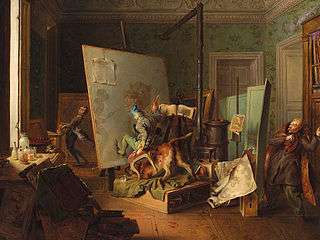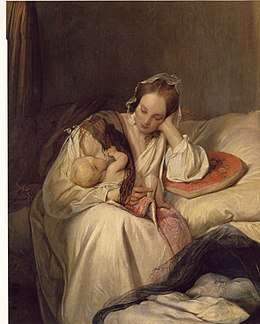Josef Danhauser
Josef Danhauser (August 19, 1805 in Laimgrube (now a part of Mariahilf or Neubau) – May 4, 1845) was an Austrian painter, one of the main artists of Biedermeier period, together with Ferdinand Georg Waldmüller, Peter Fendi, among others. His works, not very appreciated in his days, dealt with very moralising subjects and had a clear influence of William Hogarth.

Biography
Joseph Danhauser was born in Vienna in 1805, the eldest son of sculptor and furniture manufacturer Joseph Ulrich Danhauser and his wife Johanna (née Lambert).
He took his first painting lessons with his father and later assisted the Vienna Academy of Fine Arts. He studied with Johann Peter Krafft and made his first exhibition 1826.
Invited by Johann Ladislaus Pyrker, patriarch of Venice, he visited the city of Doges, where he started to study the Italian masters. He came back to Vienna via Trieste in 1827, visiting Prague. On March 27, 1827 he and his colleague de:Johann Matthias Ranftl molded Ludwig van Beethoven's death mask, roughly 12 hours after his death[4][5] and Danhauser painted a water-colour representing his deathbed. In 1828, he spent some time in Eger, with an invitation of this Hungarian city archbishop Pyrker. He solicited him for some pictures for the gallery of the Archdiocese.[6]
After his father's death in 1829, his brothers and he managed his furniture factory during the Biedermeier movement, being the precursors of modern design. That made him put his painting career aside.
In 1833, he responded to a second invitation from Eger's archbishop and he painted The martyr of Saint John for a new basilica in the city and he received the Vienna Academy prize for his picture Die Verstoßung der Hagar and he specialised in Genre works. In 1838, he was appointed vice-rector of the Academy and married Josephine Streit, who was the daughter of a physician and with whom he had three children, Josef, Marie and Julie, born in 1839, 1841 and 1843 respectively.
Josef Danhauser was appointed professor of historical Painting at the Academy in 1841, but he left this occupation and he travelled around Germany and the Netherlands with the textile maker, art aficionado and art sponsor Rudolf von Arthaber. In this journey, he was very interested in the Dutch School and the format of his works was smaller. He died of typhus in Vienna in 1845 and was buried in Hundstrumer Cemetery, though his grave was later moved.[7][8] In 1862, a street was named after him in Vienna.
Works
(dimensions given in metres)
- Rudolf von Habsburg und der Einsiedler in der Kapelle von Lilienfeld (1825), oil on canvas, 0.727 x 0.588, Budapest, Szépművészeti Múzeum
- Wallenstein ersticht sich im Zelte Ottokars - Szene aus Pyrkers Rudolphias (1825), oil on canvas, 0.59 x 0.738, Budapest, Szépművészeti Múzeum
- Ottokar erklärt Rudolf auf dem Turnierplatz mitten im Sturm den Krieg (1825), oil on canvas, 0.603 x 0.741, Wien Museum

(oil on canvas, 1829)
- Das Scholarenzimmer eines Malers (1828), oil on canvas, 0.40 x 0.52, Vienna, Österreichische Galerie Belvedere
- Komische Szene in einem Maleratelier (1829), oil on canvas, 0.365 x 0.495, Vienna, Österreichische Galerie Belvedere
- Bildnis eines Knaben (1829), oil on canvas, 0.42 x 0.345, Wien Museum
- Porträt Ladislaus Pyrkers, oil on paper, 0.32 x 0.26, Vienna, Österreichische Galerie Belvedere
- Maleratelier mit Jeanne d'Arc (1830), oil on canvas, 0.78 x 1.035, Budapest, Szépművészeti Múzeum
- Selbstporträt (1830–1835), oil on wood, 0.233 x 0.20, Wien Museum
- Die Schlafenden (1831), oil on canvas, 0.685 x 0.51, Budapest, Szépművészeti Múzeum
- Ottokars Tod (1832), oil on canvas, 1.035 x 0.845, Budapest, Szépművészeti Múzeum
- Der letzte Kampf zwischen Rudolf und Ottokar (1832), oil on canvas, 0.585 x 0.695, Budapest, Szépművészeti Múzeum
- Porträt der Frau von Streit, der Schwiegermutter des Künstlers (1833), oil on canvas, 0.92 x 0.715, Linz, Oberösterreichischen Landesmuseen
- Abraham verstößt Hagar (1833), oil on canvas, Vienna, Österreichische Galerie Belvedere
- Das Bekenntnis (1834), oil on canvas, 1.28 x 0.96, Wien Museum
- Die Frau des Fischers mit ihrem Kinde (1835), oil on wood, 0.41 x 0.49, private collection.

(oil on canvas, 1839)
- Der reiche Prasser (1836), oil on canvas, 0.855 x 1.33, Vienna, Österreichische Galerie Belvedere
- Der abgewiesene Freier (1836), oil on wood, 0.63 x 0.486, Wien Museum
- Die Frau des Fischers am Meeresufer (1837), oil on wood, 0.395 x 0.485, Vienna, Österreichische Galerie Belvedere
- Der Augenarzt (1837), oil on canvas, 0.94 x 1.25, Wien Museum
- Die Klostersuppe (1838), oil on wood, 0.855 x 1.30, Vienna, Österreichische Galerie Belvedere
- Das Lotterielos (1838), oil on canvas, 0.885 x 0.71, Wien Museum
- Die Testamentseröffnung (1839), oil on wood, 0.95 x 1.19, Vienna, Österreichische Galerie Belvedere
- Der Pfennig der Witwe (1839), oil on canvas, 0.97 x 1.27, Salzbourg, Residenzgalerie
- Die Schachpartie (1839), oil on canvas, 1,35 x 1,75, Vienna, Österreichische Galerie Belvedere
- Die Mutterliebe (1839), oil on canvas, 0.507 x 0.42, Vienna, Österreichische Galerie Belvedere
- Wein, Weib und Gesang (1839), Vienna, Österreichische Galerie Belvedere
- Franz Liszt, am Flügel phantasierend ("Franz Liszt Fantasizing at the Piano") (1840), Berlin, Alte Nationalgalerie[9]
- Porträt des Klavierfabrikanten Konrad Graf (1840), oil on wood, 0.82 x 0.63, Vienne, Österreichische Galerie Belvedere
- Die Zeitungsleser (1840), oil on wood, 0.21 x 0.17, Vienna, Österreichische Galerie Belvedere
- Die Frau vom Meer (1840), oil on wood, 0.51 x 0.39 [10]

(oil on wood, 1840)
- Der Astronom Karl Ludwig Edler von Littrow und Gattin Auguste geb. Bischoff (1841), oil on paperboard, 0.50 x 0.38, Wien Museum
- Die Hundekomödie (1841), oil on canvas, 0.603 x 0.658, Wien Museum
- Die Romanlektüre (1841), oil on canvas, 0.63 x 0.788, Munich, Galerie Grünwald
- Madame Lenormand weissagt der Kaiserin Josephine die Trennung von Napoleon (1841), oil on wood, 0.74 x 0.83, lost picture
- Das Kind und seine Welt (1842), oil on wood, 0.226 x 0.29, Wien Museum
- Die kleinen Virtuosen (1843), oil on paperboard, 0.40 x 0.365, Vienna, Österreichische Galerie Belvedere
- Das A-B-C (1843), oil on wood, 0.385 x 0.355, Wien Museum
- Die Brautwerbung (1844), oil on wood, 0.45 x 0.57, private collection
- Der Gottscheer Junge (1844), oil on wood, private collection
- Bildnis Franz von Schober (1844), oil on wood, 0.16 x 0.13, Wien Museum
- Die aufgehobene Zinspfändung (1844), oil on wood, 0.90 x 1.08, Linz, Oberösterreichischen Landesmuseen
- Die Dorfpolitiker (1844), oil on wood, 0.36 x 0.406, Vienna, City Galerie
- Das Stiegenweibchen (1845), oil on wood, 0.42 x 0.335, Vienna, Galerie Hassfurthe
- Franz Stelzhamer (1845), oil on canvas, 0.74 x 0.60, Linz, Oberösterreichischen Landesmuseen
- Franz Danhauser, der Bruder des Künstlers (1845), oil on paperboard, 0.343 x 0.272, Wien Museum
References
- After the golden age: romantic pianism and modern performance by Kenneth Hamilton, p. 83, Oxford University Press 2008, ISBN 978-0-19-517826-5
- "Liszt at the Piano" by Edward Swenson, June 2006
- Franz Liszt, am Flügel phantasierend Archived 2012-06-30 at Archive.today at Stiftung Preußischer Kulturbesitz
- Le Menestrel, 2832, year 51, nr.28, page 222 (June 1885).
- "Beethoven Haus, Bonn" (PDF). (589 KB)
- Biography of Josef Danhauser, Gallery of Art
- "Josef Franz Danhauser – Wien Geschichte Wiki". www.geschichtewiki.wien.gv.at (in German). Retrieved 2020-05-30.
- "Hundsturmer Friedhof (12, Haydnpark) – Wien Geschichte Wiki". www.geschichtewiki.wien.gv.at (in German). Retrieved 2020-05-30.
- Franz Liszt, am Flügel phantasierend Archived 2012-06-30 at Archive.today at Stiftung Preußischer Kulturbesitz
- "Past Auction: Die Frau vom Meer". artnet.com. Archived from the original on 27 November 2017. Retrieved 27 November 2017.
Bibliography
- Birke, Veronika (1983) Josef Danhauser (1805-1845), Gemalde Und Zeichnungen, Wien: Osterreichischer Bundesverlag. ISBN 978-3-215-05290-3
External links
| Wikimedia Commons has media related to Josef Danhauser. |
- Danhauser, Josef, in Constant von Wurzbach, Biographisches Lexikon des Kaiserthums Oesterreich, 3. Band, Wien 1858.
- Danhauser, Joseph Karl Weiß In: Allgemeine Deutsche Biographie (ADB). Band 4, Duncker & Humblot, Leipzig 1876, S. 726–729.